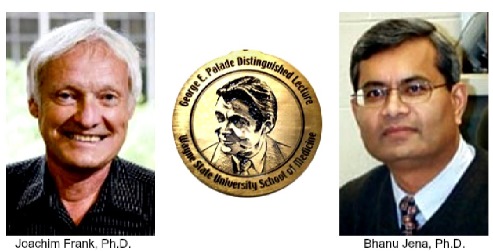
Columbia University biophysicist Joachim Frank, Ph.D., joins the ranks of Nobel Prize winners who have also accepted the Wayne State University School of Medicine's George E. Palade Gold Medal Award and Lecture for their contributions to the field of cell biology.
Dr. Frank received the Nobel for developing cryo-electron microscopy, which revolutionized the ability to study the structure of biomolecules. He developed the image analysis methods to allow ensembles of biomolecules to be put together and produce 3D images from 2D images.
George Palade, Ph.D., who died in 2008 at the age of 95, is considered the father of modern cell biology. He shared the Nobel Prize for Physiology or Medicine in 1974 with Professors Albert Claude and Christian de Duve for pioneering studies in the 1950s and 1960s defining the structure and function of cellular components, including the ribosome, secretory vesicles and endoplasmic reticulum.
Dr. Frank won the George E. Palade Award from the School of Medicine in 2008, and is now the fourth Palade honoree to also be named a Nobel laureate.
The award was established in 2003 under the leadership of Wayne State University President Irvin Reid, with permission from Professor Palade. Its first recipient was Günter Blobel, who won the 1999 Nobel Prize in Physiology or Medicine for his pioneering discovery in the 1970s and 1990s that proteins have intrinsic signals that govern their transport and localization in the cell. The Palade Award has been given to 13 individuals. Two more 2008 Palade winners -- Ada Yonath, Ph.D., and Thomas Steitz, Ph.D. -- shared the Nobel Prize for Chemistry in 2009. In 2013, Wayne State University awarded the final honoree, Arthur Horwich, for his pioneering studies elucidating our understanding of protein folding.
WSU School of Medicine Distinguished Professor of Physiology Bhanu Jena, Ph.D., is the only Wayne State University faculty member to have received the George E. Palade Award, winning it in 2005. Dr. Jena and his research team discovered a new cellular structure called the porosome. Dr. Jena is among Dr. Palade's grand-mentees, meeting when Dr. Jena was a faculty member at Yale University. His utilization of new nanotechnologies, such as atomic force microscopy, in combination with conventional technologies like electron microscopy, biochemistry and electrophysiology, "brought understanding of the cell to a new next level," reads a 2003 article from Pancreatology, the journal of the International Association of Pancreatology, the European Pancreatic Club and other national societies.
In the same year, Babes-Bolyai University in Romania jointly honored Professors Jena, Blobel and Palade, who was of Romanian origin, with an honorary doctorate in Medicine.